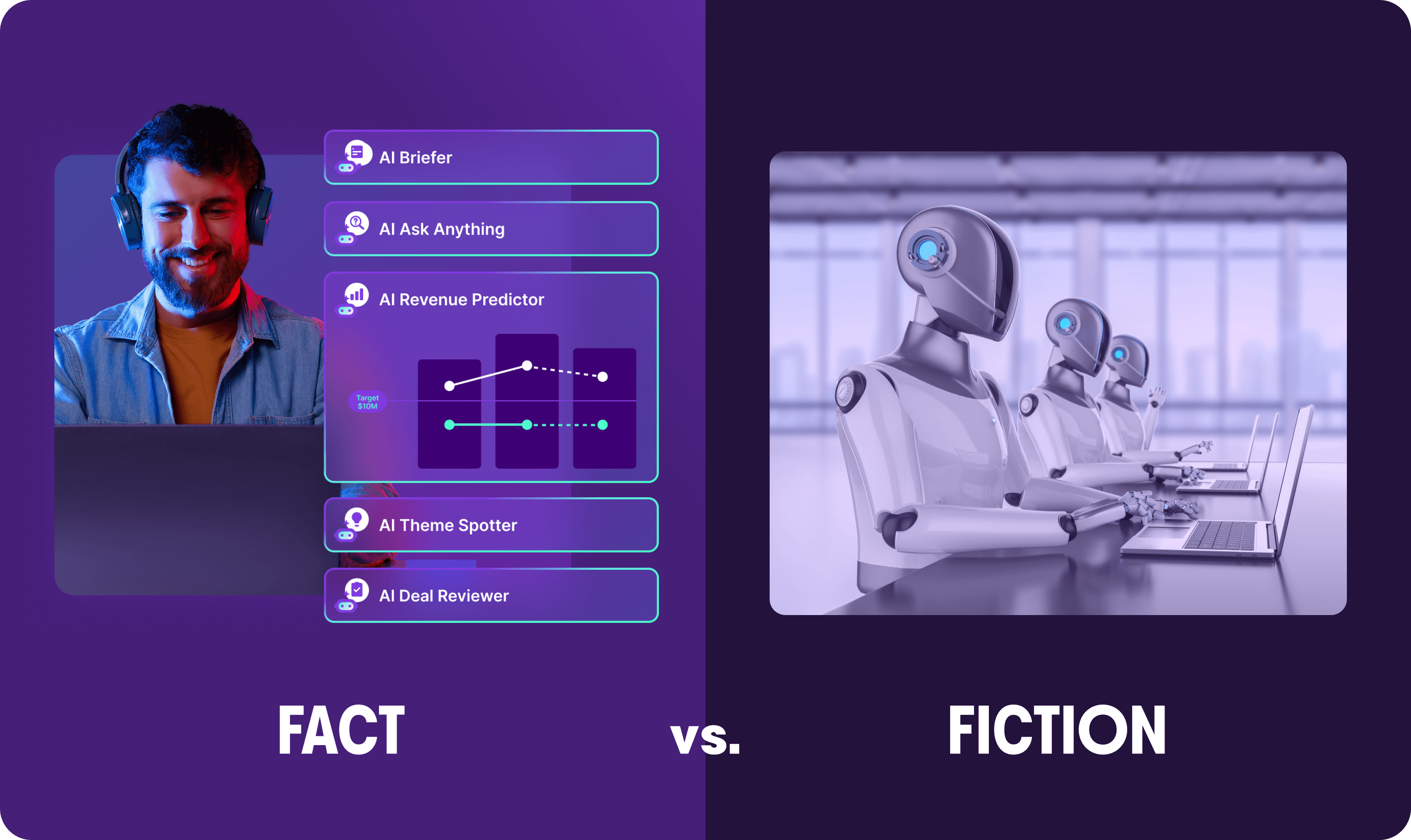Sales engagement
The truth about cold calling in today’s sales environment

Chris Orlob
Content Author
Published on: March 29, 2018

Is cold calling dead?
No. But it is a game of inequality.
On paper, the average success rate is dismal (as low as 1.48%*).
As a result, many people conclude that cold calling is dead.
But averages often obscure what’s really going on.
Here’s the reality…
Most salespeople are failing miserably at cold calling.
Much less than a 1% success rate.
But a small minority enjoy a massively unfair of the success.
There’s a HUGE divide between the “haves” and the “have-nots.”
While the “have-nots” flounder with <1% success, the “haves” are the salespeople who are sure to get the meeting every time the customer picks up the phone.
This is their story, Part I.
What are they doing differently?
To understand what correlates with cold calling success, we threw some data at the question.
We have a rapidly growing database of over 1 million sales call recordings.
90,380 of those are outbound, connected cold calls.
We analyzed the content of those calls with natural language processing to identify the anatomy of a successful cold call.
Successful cold calls were defined as those that ended up in a held follow-up meeting.
To maximize the accuracy of the insights, we filtered out “no answer” and IVR calls.
Hold onto your wallets.
Let’s take a look at what we uncovered.
“Buying Time” Is the Name of the Game
Successful cold calls were almost twice as long as unsuccessful cold calls.
The longer the call, the greater your odds of getting the meeting.
In short, the job of the cold caller is to buy time. It’s to get and hold the prospect’s attention.

But buying time is incredibly hard to do.
Cold calls are at constant risk of being ended prematurely by the buyer.
That’s why every move you make should be planned out in advance.
Ad-libbing cold calls is unlikely to work.
You should know the exact paths your buyer could go down, and how to respond to each of those.
You should know exactly what you’re going to say to grab their attention at the outset since that’s where the call is most likely to end.
A great way to do this is to steal John Barrows’ favorite introduction for opening cold calls.
After introducing yourself, start every cold call with this line:
“… The reason for my call is…”
As John points out, if you cannot finish that sentence, you should not be making the call.
From that point, every sentence you utter should be scrutinized with these two questions:
- Does it keep the buyer on the phone?
- Does it progress the conversation?
When you put your cold calling routine under this microscope, you become much more intentional about what you choose to say.
Educate, Don’t Interrogate
“You were born with two ears and one mouth. listen twice as much as you talk.”
This advice is actually irrelevant when it comes to cold calling.
Cold calling isn’t about discovery.
It’s about selling the meeting.
In fact, the talk-to-listen ratio for successful cold calls is actually higher (more talking, less listening) than unsuccessful ones:
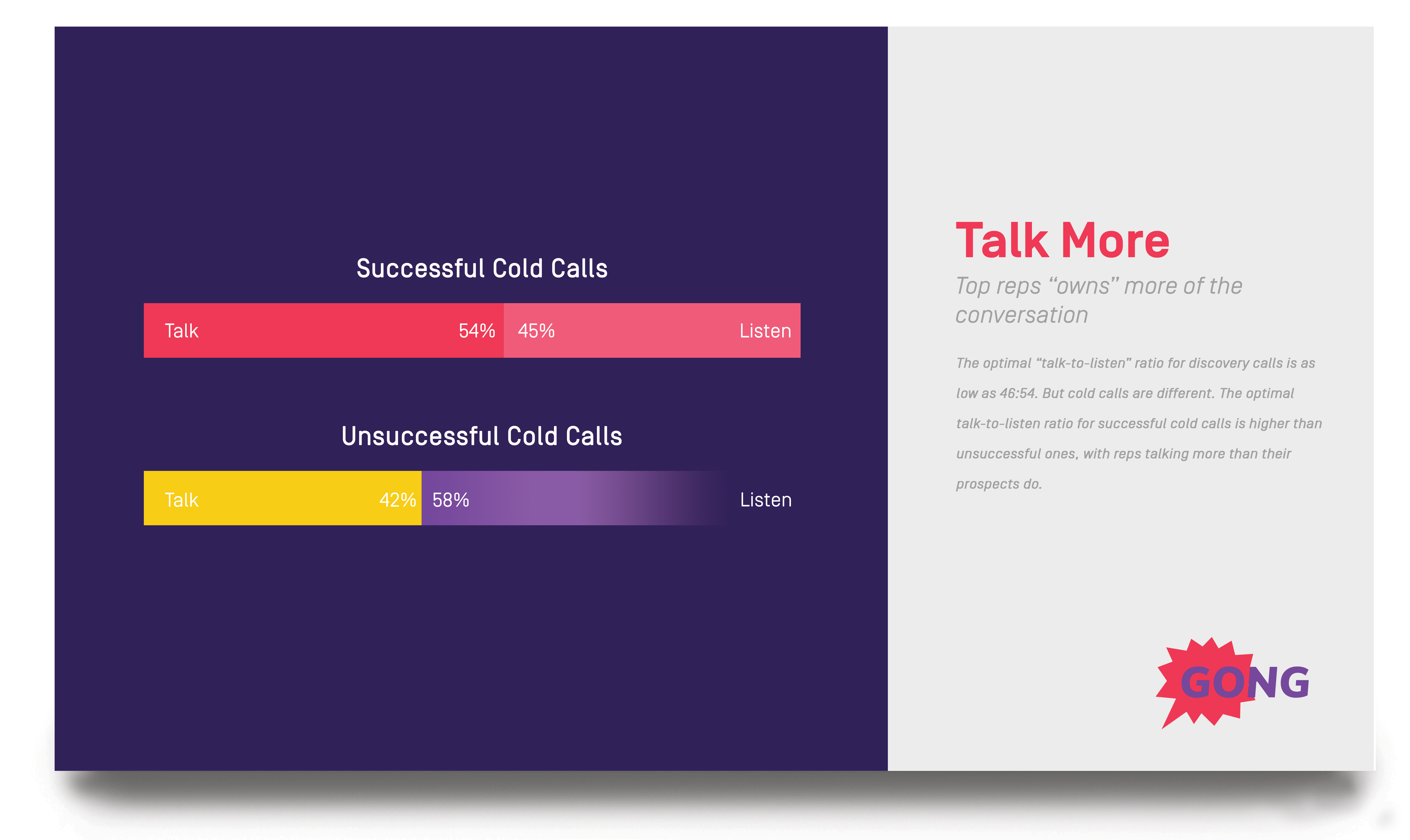
The rep “owns” more of the conversation than in other types of sales calls (such as discovery).
That’s because to get someone to agree to a meeting, you have to inform and educate them.
You have to sell them on why they should attend the meeting.
At-length discovery is usually not tolerated on cold calls.
(Ever tried asking “ What are your top priorities…” at the outset of a cold call? How’that work out for you?)
Counterintuitively, we found that successful cold calls involve longer (not shorter) “monologues” from the sales rep:
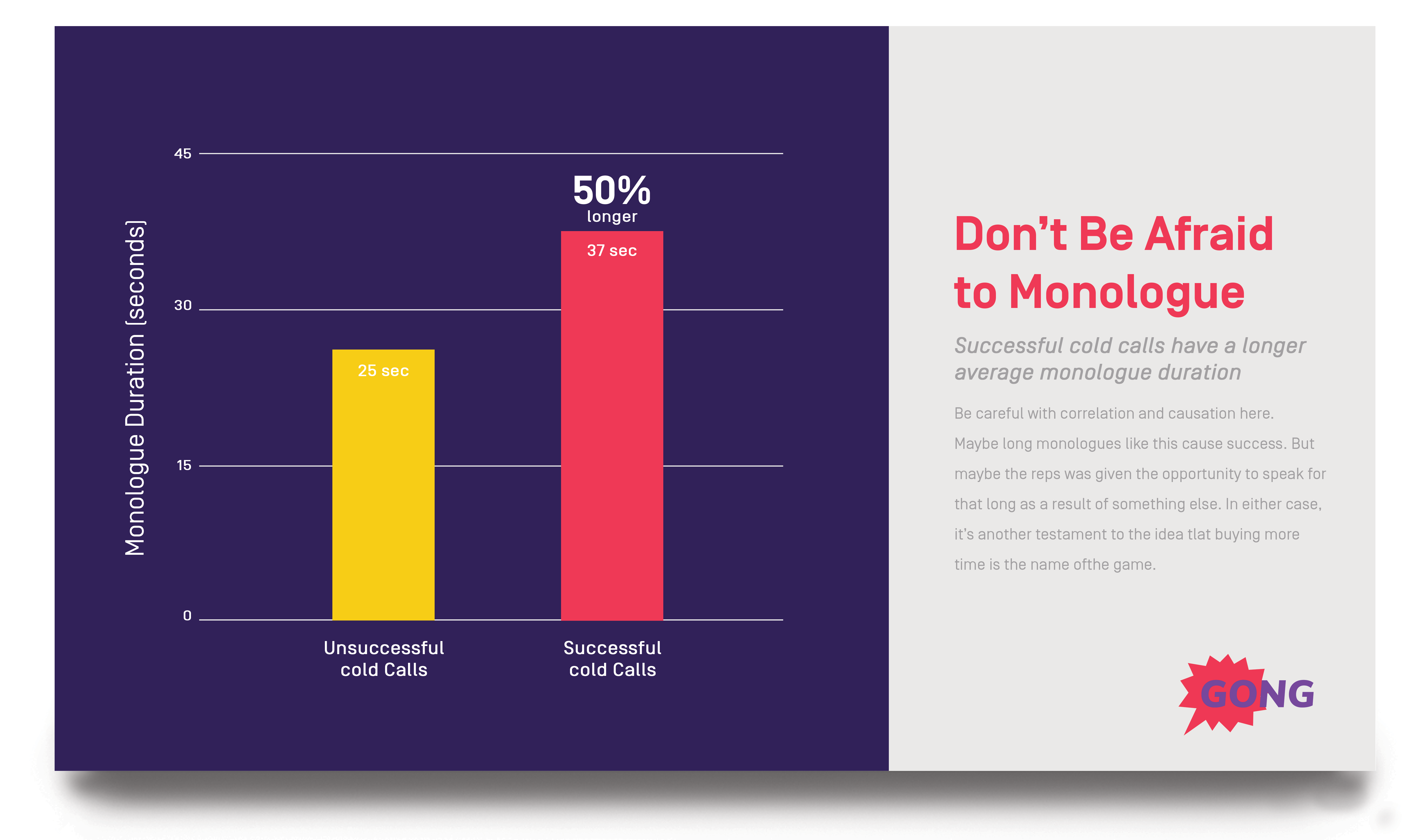
The average “ longest burst of talking” in a successful cold call is 37 seconds.
By contrast, it’s only 25 seconds in unsuccessful cold calls.
Successful cold calls have 50% longer uninterrupted bursts of talking.
Yep, you read that right.
Successful cold calls also involve more frequent “monologues” from the sales rep.
There are 70% more 5+ second monologues in successful cold calls – 20 vs. 12 per call:
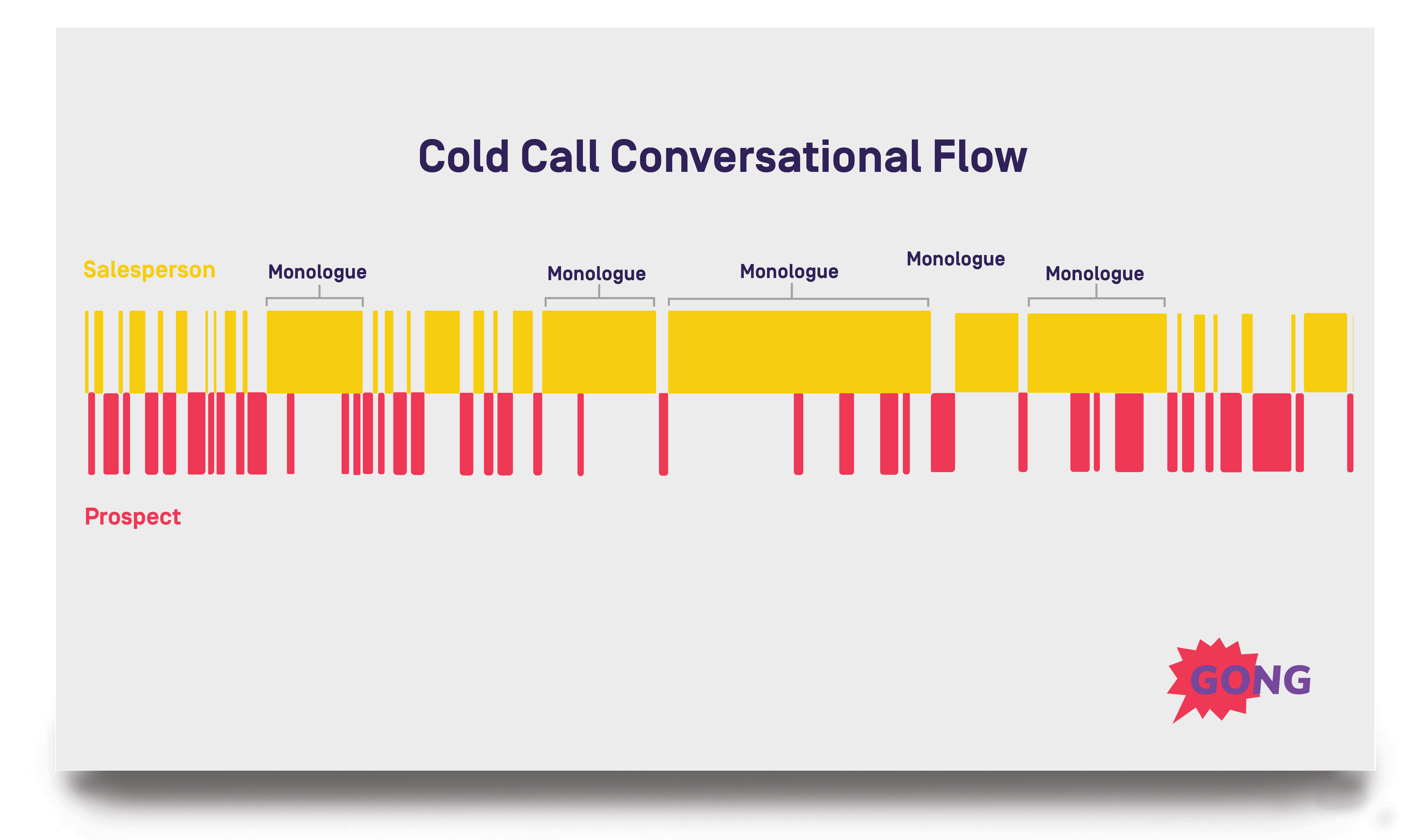
Number of monologues: 20 monologues per call vs. 12. 70% more monologues (rep speaking for 5s or longer)
Let’s contrast these data points with what’s going on on the prospect’s side of the conversation.
The average prospect monologue length (how long you can get the prospect to talk uninterrupted) in successful cold calls is only 3.5 seconds.
It’s 8 seconds in unsuccessful cold calls:
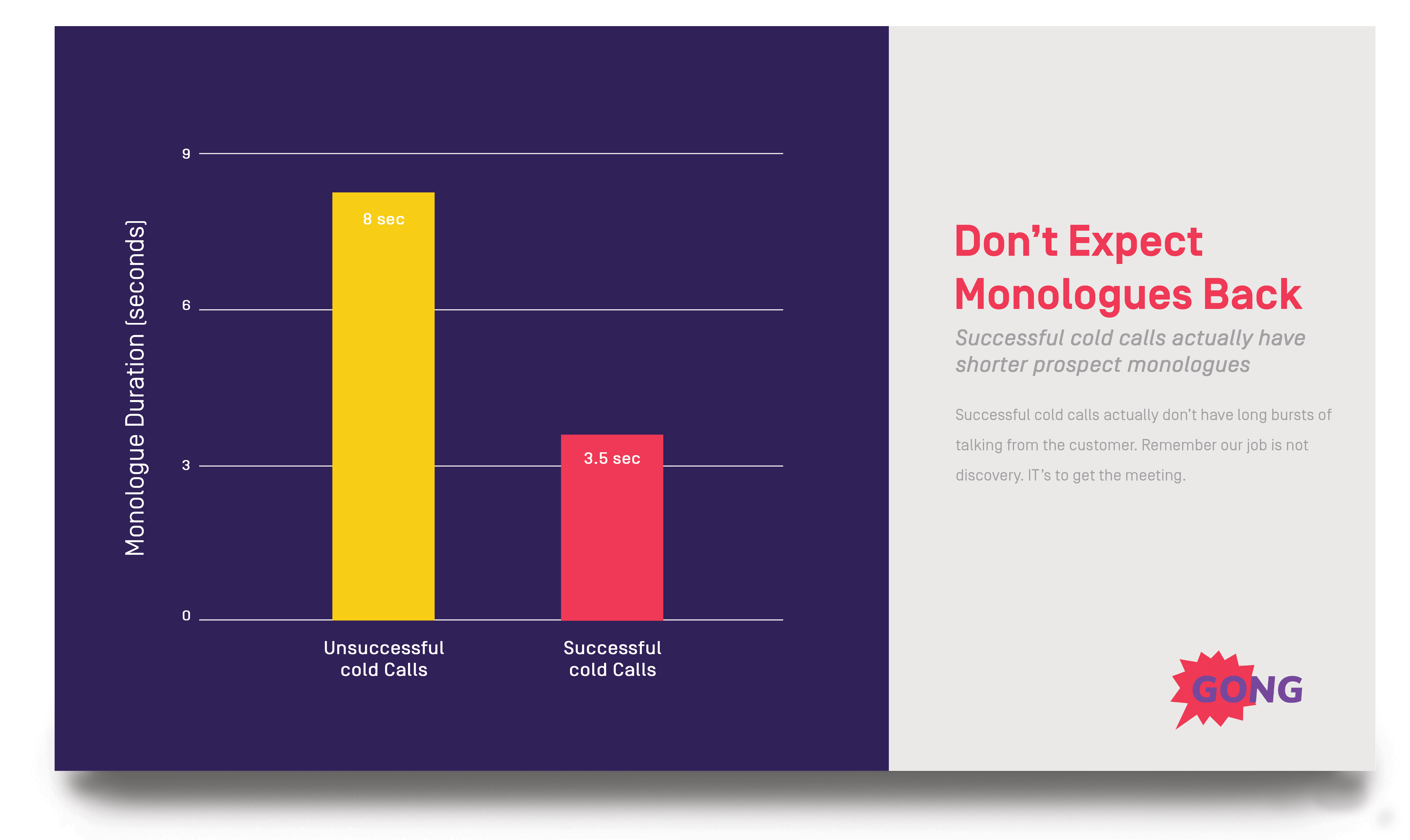
Like I said earlier, the job of a cold call is not discovery.
It’s to sell the meeting.
Don’t get me wrong.
A few economically-placed discovery questions might help.
It’ll give you the information you need to make a better pitch as to why they should attend the meeting.
But you have to earn the right to ask questions on a cold call.
And bombarding your prospect with the entire SPIN Selling questions sequence is unlikely to go well.
It’s overkill.
In fact, successful cold calls don’t involve the rep asking more questions than unsuccessful ones.
Successful and unsuccessful cold calls had no statistical difference in the number of questions asked by the rep.
The takeaway is that the name of the game is crafting a highly personalized “pitch” for why the buyer should agree to a meeting.
Intelligent pre-call research combined with a few economical questions is your best bet for getting there.
Need more data? Check these 8 mind-blowing cold call stats.
Nail Your Opening Line
Cold calls are won inch-by-inch.
Every second counts.
That’s why the way you open the cold call – your opening line – is an inflection point of how the call will turn out.
A strong opening line buys you another 30 seconds of conversation.
Nailing that opening line is what’s in store for our next post.
Obviously, we’ve only scratched the surface of what data can tell us about successful cold calling.
We’ll have a few more posts in this series that further illustrate the anatomy of a successful cold call.
The next one is scheduled for 2 weeks from today.
Liked what you read and want to with your friends and colleagues? Here’s The Gong.io Cold Calling Training Deck.
***Update: The post on cold call opening lines is now live***
Download the Cold Calling Tips Cheat Sheet
We created a printable cheat sheet of the key cold calling tips from this blog post.
Take a look, and download the cheat sheet here:

Download it, print it out, and tape it to your wall for everyone to learn from.
If you liked this article you may also be interested in Cold Calling – The 14 Best Tips of All Time for Salespeople

Content Author
Chris Orlob is the Co-Founder and CEO of Pclub.io, a leading sales training platform designed to help sales professionals accelerate their revenue growth. He is best known for his pivotal role at Gong, where he helped scale the company from $200,000 to $200 million in ARR, contributing to a $7.2 billion valuation. During his tenure at Gong, Chris led the creation of Gong Labs and excelled in various go-to-market roles. Today, through Pclub.io, he leverages his deep expertise in sales and revenue operations to coach over 11,000 SaaS sellers.
Discover more from Gong
Check out the latest product information, executive insights, and selling tips and tricks, all on the Gong blog.



